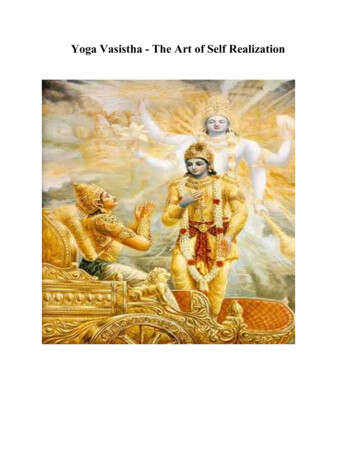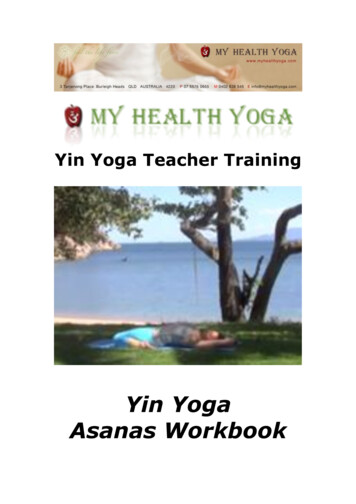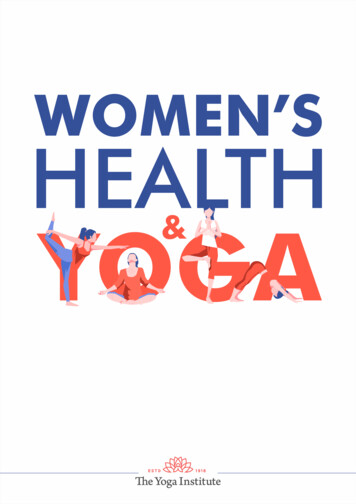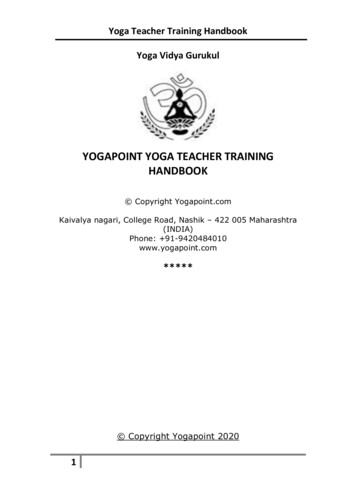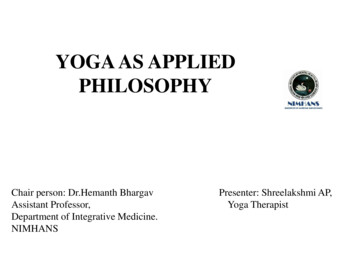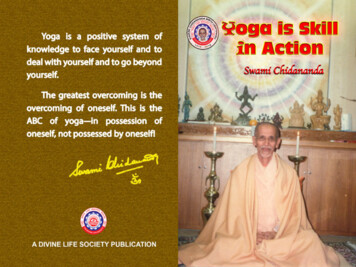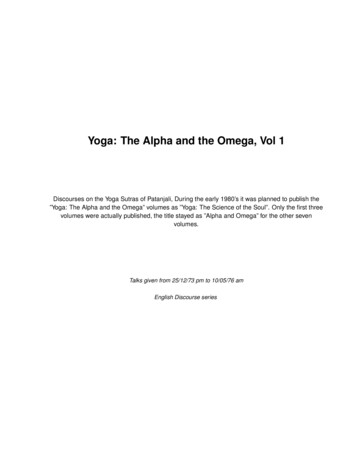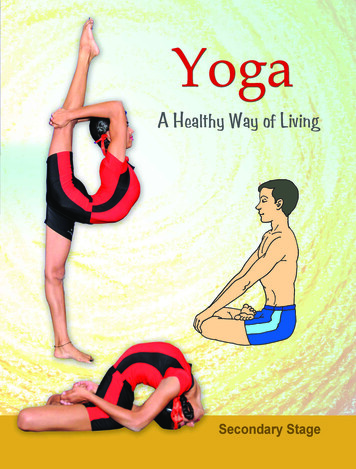
Transcription
YogaA Healthy Way of LivingSecondary Stage
ISBN 978-93-5007-344-5First EditionJune 2015 Jyaishtha 1937ALL RIGHTS RESERVED No part of this publication may be reproduced, stored in a retrievalsystem or transmitted, in any form or by any means, electronic,mechanical, photocopying, recording or otherwise without the priorpermission of the publisher. This book is sold subject to the condition that it shall not, by way oftrade, be lent, re-sold, hired out or otherwise disposed of withoutthe publisher’s consent, in any form of binding or cover other thanthat in which it is published. The correct price of this publication is the price printed on this page,Any revised price indicated by a rubber stamp or by a sticker orby any other means is incorrect and should be unacceptable.PD 5T BS National Council of EducationalResearch and Training, 2015OFFICES OF THE PUBLICATIONDivision, NCERT 50.00NCERT CampusSri Aurobindo MargNew Delhi 110 016Phone : 011-26562708108, 100 Feet RoadHosdakere Halli ExtensionBanashankari III StageBangaluru 560 085Phone : 080-26725740Navjivan Trust BuildingP.O.NavjivanAhmedabad 380 014Phone : 079-27541446CWC CampusOpp. Dhankal Bus StopPanihatiKolkata 700 114Phone : 033-25530454CWC ComplexMaligaonGuwahati 781 021Phone : 0361-2674869Publication TeamPrinted on 120 GSM Imported ArtPaperPublished at the Publication Divisionby the Secretary, National Council ofEducational Research and Training,Sri Aurobindo Marg, New Delhi110 016 and printed at Shr eeVrindavan Graphics (P) Ltd., E-34,Sector-7, Noida 201 301 (UP)Head, PublicationDivision: Dinesh KumarChief Editor: Shveta UppalChief BusinessManager: Gautam GangulyChief ProductionOfficer (Incharge): Arun ChitkaraEditor: Bijnan SutarProductionAssistant: Mukesh GaurCoverD. K. Shende
ForewordThe National Council of Educational Research andTraining (NCERT) takes the pride of contributing throughthis book entitled Yoga: A Healthy Way of Living meantfor school children while celebrating International YogaDay on 21 June. Yoga is an integral part of 'Health andPhysical Education' which is a compulsory subject uptosecondary stage. This curricular area adopts a holisticdefinition of health within which Physical Education andYoga contribute to the physical, social, emotional andmental development of a child. Yoga has been consideredto be introduced from Class VI onwards, though yogicactivities may begin in an informal way from primary levelonwards. The present book is meant for secondary stage.This book includes three Units. Unit 1 is an IntroductoryUnit, explains in brief the origin and history of yoga and thegeneral guidelines for doing yogic activities. The emphasisof other two units is on personality development andmanaging stress among adolescent children through yogicpractices and adopting other yogic principles. Developingphysical fitness, emotional stability, concentration andmental development of students through yoga have alsobeen given due emphasis in.The book is more practice oriented aligning with thesyllabi of yoga and holistically dealing with ‘Health andPhysical Education’. Each unit gives a brief description ofAsanas, Pranayamas, Kriyas and Meditation followed bythe successive actions or steps of these yogic practices.The material is explained in simple language and alsoprofusely illustrative so that the students can learn andpractice it even at home. This material can also be usedby others who wish to learn some common and importantyogic practices for healthy living.
ivThe success of this effort will depend on the stepsthat school principals and teachers will take to encouragechildren to do these practices and reflect on their learning.I am deeply indebted to all the team members and othersfor their invaluable help in preparing this material. I amspecially thankful to Professor Saroj Yadav, Dean andNational Project Coordinator of NPEP and AEP for hercontinuous effort to develop this material in the presentform.However, an organisation committed to systemicreform and continuous improvement in the quality of itsproducts, NCERT welcomes comments and suggestionswhich will enable us to undertake further revision andrefinement.It is hoped that students will find it useful.B. K. TripathiDirectorNational Council of EducationalResearch and TrainingNew Delhi5 June 2015
About the BookThe National Council of Educational Research and Trainingon the eve of International Yoga Day to be observed on 21June, has developed textual material on yogic activitiesfor students of upper primary and secondary stages. Thistextual material is meant for the students of secondarystage (Classes IX and X). It includes various yogic activitiesto be performed by the students of these classes. Theseactivities are an integral part of the syllabi of Health andPhysical Education brought out by the NCERT. Formalintroduction of yogic activities are from Class VI however,yogic activities in an informal way can be included at theprimary stage. In this textual material, practices of asanas,pranayama, kriyas and meditation have also been includedThe main emphasis of development of these unitsfor secondary stages are on developing personality andmanaging stress among adolescent children through yogicactivities. Developing physical fitness, emotional stability,concentration and mental development of students havealso been considered while developing this materialThere are three Units in this material. Unit 1 is anintroductory unit, explains in brief the origin and history ofYoga and the general guidelines for doing yogic activities. Italso includes specific guidelines related to yogic practices(asanas, pranayamas, kriyas and meditation, etc.). Unit2 is for students of Class IX and Unit 3 is for studentsof Class X. In these two units, a brief description of eachyogic practices followed by a description of steps or stagesfor practice have been included. Variation in techniquesof yogic practices may exist. In this material, techniqueswhich are commonly used are given. The benefits of doingthese yogic activities has been mentioned. Some importantdo’s and don’ts including limitations which have to be keptin view while practising these yogic practices have alsobeen given.
viA special feature of this material is that it is profuselyillustrated so that teachers can learn the asanas listedin the syllabus after some initial training in yogasanas.Illustrations made the material more attractive anduser friendly. The material was developed by a team.We are deeply indebted to them for their invaluable helpin preparing this material. It is hoped that student andteachers will find it useful. Comments and suggestionsare welcomed to enable us to undertake further revisionand refinement.Professor Saroj YadavDean (A) and Project CoordinatorNational Council of EducationalResearch and Training
Development TeamTeam MemberB. Islam, Ex. State Training Commissioner(s), KendriyaVidyalaya and Yoga Teacher, Kendriya Vidyalaya, AndrewsGanj, New Delhi, 110025.Bhagwati Yadav, Yoga Teacher, K.V. N.S.G. Manesar, Distt.Gurgaon (KVS R.O. Gurgaon) Haryana.C.G. Sindhe, Kaivalyadham, Lonavala, Maharashtra.Sadhana Arya, Guest Faculty, Morarji Desai NationalInstitute of Yoga, New Delhi.Vasudev Sharma, Project Officer (Yoga) Physical Education,Directorate of Education, Delhi.CoordinatorSaroj Yadav Dean Academic and Project Coordinator, (NPEPand AEP), NCERT
AcknowledgementsThe National Council of Educational Research and Trainingwishes to acknowledge the invaluable contribution ofthe experts and teachers in reviewing and updating thematerial on Yoga : A Healthy Way of Living. This workinevitably required many helping hands and without theirsupport it would not have been possible to bring out thispublication within stipulated time.We are thankful to the following for their invaluablesuggestions: Dr. Ishwar V. Basavardaddi, Director, MorarjiDesai National Institute of Yoga, New Delhi; Dr. ManikaDebnath, HOD, LNIPE, Gwalior; Dr. H.L. Khatri, LecturerDIET, Pitampura, Delhi; Shri Ashok Dhawan, CoordinatorYoga, Physical Education, Directorate of Education,Delhi: Dr. Devender Singh, Asstt. Professor, DIET, Delhi;Shri Harish Meena, Asstt. Professor, NCERT, New Delhi;Smt. Indra Sagar, Physical Education Teacher, JNV, Jafarpur,Delhi; Shri Ish Kumar, Yoga Teacher and the students ofGovt. Boys S.S., Model Town, Delhi; Smt. Neelam Arora, YogaTeacher and the students of SKV Model Town No. 1, Delhi;Ms. Suchint Kaur, Kaivalyadham, Lonavala, Maharashtra;Smt. Sarita Sharma, Yoga Teacher, Govt. SKV, Sector – 4-5and the students of S-4,5, R.K. Puram, Delhi; and Dr. VipinAnand, Yoga Teacher, KV, JNU, New Delhi.We are also thankful to Ms. Seema Jabeen Hussainand Shri Fajruddin for illustrating the book. We alsoacknowledge the sincere efforts made by Smt. ShashiChadha for copy editing the book.We appreciate the special effort put in by Shri BijnanSutar, Editor; Shri Mathew John, Editorial Assistant, andShri Mukesh Kumar Gaur, Production Assistant of PublicationDivision in bringing out this publicatin in time.Special thanks to Ms. Rani Sharma (PA), Shri Nitin KumarGupta and Shri Ajeet Kumar, DTP Operator; Ms. Kirti,Computer Typist for typing and designing this book.
ContentsForewordiiiUnit 1 : IntroductionOverviewWhat is YogaImportance of YogaYoga – Its HistoryObjectives of Yogic PracticesGeneral Guidelines for Yogic PracticesCommon Yogic Practices Yama and Niyama Asana Pranayama Pratyahara Bandha Mudra Shatkarma/Kriya Meditation111223345567788Unit 2 : Personality Development through YogaOverviewYoga and Personality DevelopmentYogic Practices for Personality Development Surya NamaskarAsanas Tadasana Katichakrasana Simhasana Mandukasana Uttana-mandukasana Kukkutasana Akarna Dhanurasana Matsyasana9991112151617182021232425
x Bhujangasana Makarasana Shalabhasana Dhanurasana Sarvangasana Halasana ShavasanaKriyas Kapalabhati AgnisaraPranayama Anuloma-Viloma Pranayama Bhastrika PranayamaBandha Uddiyana BandhaDhyana (Meditation) Meditation2728293132343637373839404142424444Unit 3 : Yoga for Stress ManagementOverviewWhat is StressYoga as a Way of Life for Stress Management Ahara Vihara Achara Vichara VyavaharaYogic Practices for Stress ManagementAsanas Hastottanasana Padahastasana Trikonasana Shashankasana Ushtrasana Ardhamatsyendrasana Bhujangasana Makarasana 64
xi Matsyasana ShavasanaKriyas KapalabhatiPranayama Anuloma-Viloma Pranayama Bhastrika Pranayama Bhramari Pranayama Sheetali PranayamaYognidra Body Awareness Breath Awarness Coming BackMeditationYoga for Healthy Living Shirshasana Bakasana Hamsasana Mayurasana64646565656565666768696970717171737476
Unit 1IntroductionOverviewYoga is a healthy way of life, originated in India. Now it is believed tobe a form of science accepted all over the world. The western culturealso is accepting it as a healthy form of scientific exercise. Althoughthe origin of yoga is obscure, it has a long tradition. In course oftime, various schools of yoga developed. The major schools of yoga areJnana yoga, Bhakti yoga, Karma yoga and Raja yoga. These schoolsof yoga advocate particular type of methodology which includes avariety of systematised practices of yoga depending on their particularapproach. However, all these are leading to the common goal of selfrealisation and integration of body and mind.Yoga for a common person contains the practices of yama,niyama, asana, pranayama, pratyahara, kriya, mudra, bandha andmeditation which are helpful to keep oneself physically fit, mentallyalert and emotionally balanced. This ultimately prepares ground forthe spiritual development of an individual.The main emphasis of the present yoga curriculum for schoolgoing children is to develop their physical fitness, mental developmentand emotional stability rather than on the spiritual aspect of yoga.Postures or asanas form an important basis of this curriculum.These have, therefore, been given more weightage. Though, otheryogic activities have also been included in the curriculum.WhatisYoga?The word 'Yoga' is derived from Sanskrit root yuj which means 'join'or 'unite'. This may be taken as the union of body, mind and soul,and is used in the literature both as an end as well as means. Asan end, yoga signifies 'integration of personality' at the highest level.As means, yoga includes various practices and techniques whichare employed to achieve the development of such integration. Thesepractices and techniques are means in the yogic literature and arealso referred collectively as 'Yoga'.
2ImportanceYoga : A Healthy Way of LivingofYogaGood Health is the right of every human being. But this right dependson individual, social and environmental factors. Along with socialor environmental factors to a large extent, we can develop a betterimmune system and a better perception of oneself so that otherconditions do not affect us adversely and we can achieve good health.Health is a positive concept. Positive health does not mean merelyfreedom from disease, but, it also include a jubilant and energetic feeling ofwell-being with an amount of general resistance and capacity to easilycultivate immunity against specific offending agents.There are many modern and indigenous methods and disciplinesthat can help us to successfully fight with diseases. For example,the system of yoga, naturopathy, ayurveda, unani, homeopathy andsiddha can be quoted among indigenous systems, whereas allopathicsystem is quoted as the modern and popular medical system. Yoga isone of the most powerful drugless system of treatment. It is having itsown concept of wellness which has been scientifically understood andpresented by many. Yoga can be adopted as lifestyle for promotingour physical and mental health. Yoga, if introduced at the school levelwould help to inculcate healthy habits and healthy lifestyle to achievegood health.The aim of yoga thus, at the school level, is to encourage a positiveand healthy lifestyle for physical, mental and emotional healthof children. Yoga helps in the development of strength, stamina,endurance and high energy at physical level. It also empowers oneselfwith increased concentration, calm, peace and contentment at mentallevel leading to inner and outer harmony.Yoga – Its HistoryYoga has its origin thousands of years ago in India. It has originatedfrom a universal desire towards attaining happiness and gettingrid of sufferings. According to yogic lore, Shiva is considered as thefounder of Yoga. A number of seals and fossil remains of Indus ValleyCivilisation, dating back to 2700 BC indicates that yoga was prevalentin ancient India. However, systematic reference of yoga is foundin Patanjali's Yogadarshna. Maharishi Patanjali systematised theyogic practices. After Patanjali, many sages and yogis contributedto its development and as a result, yoga has now spread all over theWorld. In this sequence, on 11 December 2014, the United Nations
3IntroductionGeneral Assembly (UNGA) with 193 members approved the proposalto celebrate 'June 21' as the 'International Yoga Day'.Objectives ofYogic PracticesTo develop a understanding of yogic practices and apply thisunderstanding accordingly in one’s life and living.To develop a healthy habit and lifestyle in children.To develop humane values in children.To develop physical, emotional and mental health through yogicactivities.General Guidelines for Yogic PracticesYoga may be introduced from the primary level onwards in informalways, but formal introduction of yogic exercises should begin onlyfrom Class VI. The yoga curriculum must address itself to the childrenand there should be some hints to them to take up a study of thissubject on their own in addition to what is being taught in the class.Yogic activities can be done by all children including children withspecial needs. However, children with special needs should performthese activities in consultation with yoga experts/yoga teacher as pertheir capacity. The yogic practices should start with a quiet mood which could beattained by reciting a short prayer.It is essential that body should be prepared by activities such asankle bending, knee bending, finger movements, hand clenching,wrist bending, wrist rotation, elbow bending, shoulder rotationand eye movement. After this, Surya Namaskara can be practised. Regularity of practice is essential both in the physical and mentalaspects of yoga.Patience is an important requirement for yoga. Do not despair ifyou do not succeed today in doing a certain asana or in followinga right principle of conduct. Perseverence in your efforts is needed.Success will come with time.Do not compete but cooperate. A spirit of competition is a definitehindrance on the path of yoga. Competitions feed our ego whileyoga helps us to rise above our ego.Yogic practices should be learnt under the guidance of experiencedteacher.
4Yoga : A Healthy Way of Living Some yogic practices should be practised on an empty or on a verylight stomach. Early morning is the ideal time for yoga practice but it can also bepractised in the evening. Yoga should not be practised in hurry or when you are exhausted. Select a well-ventilated, clean and non-disturbing place for yourpractice. Yogic practices should not be performed on hard surface. A durry,a mat or a blanket can be used for this purpose. Bathing before the practice is good. Use cold or warm water as perthe requirement of the individual and season. Clothes should be loose and comfortable while performing theyogic practices. Breathing should be as normal/natural as possible. It is not to bemanipulated unless instructed specifically to do so. There are limitations of yogic practices. If you are suffering fromany problem or chronic disease, inform your teacher before startingyogic practices . Yogic practices should be adopted on the basis of the principle ofprogress. At initial stage, easy practices should be adopted. Lateron more difficult ones can be practised. Therefore, start with simpleyogic practices and gradually proceed to do advance practices. Yogic practices should not be combined with other physicalactivities in same session. These are two different types of activitiesand could be separately practised. Yogic practices can be carried on at home once they are properlylearnt in the school. Yoga has a broader meaning. Therefore, apart from asana andpranayama, one should practise moral and ethical values in life.Common Yogic PracticesYogic texts propound several practices such as yama, niyama, asana,pranayama, pratyahara, shatkarma (cleansing practices), mudra,bandha, dharana, dhyana (meditation). Here, we will discuss thosepractices which are commonly used.
Introduction5Yama and NiyamaThese are initial sets of principles that are concerned with our conductin personal and social life. These are related to ethics and values.AsanaThe term asana means sitting in a particular posture, which iscomfortable and which could be maintained steadily for long time.Asana gives stability and comfort, both at physical and mental level.There may be variations in the techniques of some of the asanasdepending upon the following yoga institutions.Asana may broadly be classified into three categories:(a) Cultural or Corrective asana(b) Meditative asana(c) Relaxative asanaCultural asanas can further be classified into two groups, dependingon the effects produced:(i) asana that work through and on the spine and visceral organs.(ii) asanas that work through the skeletal muscles, ligaments andjoints.Meditative asanas are those asanas which are aimed at quiet sittingand are used for higher practices in yoga. padmasana, swastikasana,sukhasana and siddhasana can be put in this category.Relaxative asanas are those which remove tension and bring aboutphysical as well as mental relaxation. The important asanas in thiscategory are shavasana and makarasana.Guidelines for the Practice of Asanas Generally, the asanas are practised in the sequence of standing,sitting, prone-lying and supine-lying position. Though there isother version which follows different sequence. Asanas must not be practised in haste or by applying any sort ofundue force and under an urgency. Jerks should be avoided. Asanas should be performed with body and breath awareness.There should be coordination between breath and movement ofbody-parts. As a general rule, inhale while raising any part of the body andexhale when bending down.
6 Yoga : A Healthy Way of LivingThe practitioner has to follow instructions sincerely with optimalattention.Final position should be attained slowly step-by-step and shouldbe maintained with closed eyes for developing an inward awarenesswithin the body.Final position of asanas must be maintained for as long as one iscomfortable. One should maintain the final posture according toone’s own limitations and should not go beyond one's capacity.During maintenance of final position of asana, there should ideallybe no tremors or any type of discomfort.An utmost care must be taken in increasing the time for maintainingthe asanas.Regular practice is essential. Body starts listening to yourcommand only after a regular and diligent training for a sufficientperiod of time. If regularity is disturbed due to some reasons, thenone should resume the practice within minimum time.In the initial phase, asanas involve de-conditioning and reconditioning processes. Therefore, initially, one may feel littlefatigued after the practice but after few days' practice, bodyand mind get adjusted and one starts experiencing a feeling ofwell-being and happiness again.PranayamaPranayama consists of the breathing techniques which are relatedto the control of breath or respiratory process. Pranayama popularlyknown as ‘yogic breathing’, involves a conscious manipulation of ourbreathing pattern.The health of the respiratory system depends upon the quality aswell as the quantity of air inhaled by the person. It also depend onthe rhythm and completeness of the breathing. Through pranayama,a practitioner advantageously works with her/his respiratory,cardiovascular and the nervous system which bring about emotionalstability and peace of mind.Pranayama has three phases known as puraka, rechaka andkumbhaka. Puraka is controlled inhalation; rechaka is controlledexhalation and kumbhaka is controlled retention of breath.Initially, the exhalation (Rechaka) may be a little more prolongedin comparison to inhalation (Puraka). Insistence on 1:2 ratio in thebeginning may prove counterproductive. As we practice, 1:2 ratio isreached in natural manner.
Introduction7Guidelines for the Practice of Pranayama Pranayama should be done preferably after the practice of asanas. Breathing in pranayama should be done through the nose onlyexcept sheetali and sheetkari. During pranayama, there should not be strain in facial muscles,eyes, ears, neck, shoulders or any other part of the body. During pranayama, eyes should remain closed. In the beginning, one should be aware about the natural flow of thebreathing. Make inhalation and exhalation prolonged in a gradualmanner. While observing breathing, attend to your abdominal movementwhich bulges a bit during inhalation and goes in a bit duringexhalation. In the beginning stage one should learn to maintain in gradualmanner the 1:2 ratio of breathing which means exhalation timeshould be double the inhalation. However, while practicingpranayama, do not make haste in resorting to any of the abovementioned ideal ratio. Kumbhaka (retention of breath) should not be performed in theinitial stage. After a prolonged practice of the 1:2 ratio, one shouldlearn the retention of breath under the guidance of a competentteacher. The ideal ratio according to tradition is 1 (puraka): 4 (kumbhaka):2 (rechaka). Kumbhaka must not be resorted to unless one hasundergone sufficient practice of 1: 2 ratio.PratyaharaYogic practice of Pratyahara means withdrawal of senses fromsense organs in order to control mind. In pratyahara the awarenessabout the external surrounding is withdrawn and is taken to inside.Introspection, studying good books are some practices which can helpin pratyahara.Bandha and MudraBandha and Mudra are the practices involving manipulation of certainsemi-voluntary and involuntary muscles in the body. These practicesbring about voluntary control and tone up the internal organs.
8Yoga : A Healthy Way of LivingShatkarma/Kriya (Cleansing Process)Shatkarma means six karmas or kriyas. The karma/kriya means'action'. Shatkarma consists purificatory processes which cleanse thespecific organs of the body by detoxifying them. The purification helpsto keep the body and mind healthy.There are six cleansing processes described in hatha yogic texts.These are Neti, Dhauti, Basti, Trataka, Nauli and Kapalabhati. Theseare used to clean the internal organs or systems by using water, airor manipulation of certain organs of the body.Guidelines for the Practice of Kriyas Kriyas should be done with an empty stomach. Therefore, theyshould be done preferably in the morning. Kriyas should be performed under supervision of an expert. Each kriya has specific process which should be strictly adhered to. Different things like water, salt, air, manipulation are used foreach kriya.MeditationMeditation is a practice which helps in concentration of the bodyand mind. In meditation, concentration is focussed for a long timeon a single object like tip of the nose, space between eyebrows, etc.It develops a sense of well-being and improves memory and decisionmaking power in the person.Guidelines for the Practice of Meditation Practice of asana and pranayama if performed before meditationwill help in developing ability to sit in one position for a considerableperiod of time in meditation. Select a peaceful calm and quiet place for the practice of Meditation. Allow your eyes to get closed gently to enter into an inner awareness. A meditative practice invites many thoughts, memories andemotions may surface on mind. Remain non-reactive to them. As you continue with this process for sometime, you may feel anabstract and a non-specific awareness of the whole body. Nowcontinue with the whole body awareness. In case of any difficultygo back to the breathing awareness. In the beginning it is, generally difficult to observe the breath.If mind wanders, do not feel guilty. Slowly but firmly bring yourattention to your breath.
Unit 2Personality Developmentthrough YogaOverviewDevelopment of personality is an important issue. Personality startsdeveloping since birth, but it assumes great importance duringadolescence, when reorganisation of personality takes place.Personality is a very common term which is used in our day-to-daylife. It tells us what type of person one is. We know that each persongenerally behaves consistently in most of the situations. The examplesof this consistency can be seen in a person who remains friendly ora person who is generally kind or helpful in most situations. Such aconsistent pattern of behaviour is termed as personality. It can becalled as the sum total of behaviour that includes attitudes, emotions,thoughts, habits and traits. This pattern of behaviour is characteristicto an individual.There are various dimensions of personality. These dimensionsare related to physical, emotional, intellectual, social and spiritualaspects of our behaviour. For a holistic personality development, yogaplays an important role.YogaandPersonality DevelopmentYogic practices are found effective for development of all dimensionsof personality.Let us talk about the yogic practices that influences developmentof different dimensions of personality.Yoga and Physical Dimension of Personality: Physical dimensionis related to our body. It means that all organs and systems of ourbody should be properly developed and function. It implies a healthybody without any disease. Yogic practices like asana, pranayama,and bandha play a beneficial role in physical development of children.There is a series of asanas and pranayamas which help to improvethe functioning of the body.
10Yoga : A Healthy Way of LivingYoga and Emotional Dimension of Personality: Yogic practicesare effective for development of emotional dimension relatedto our feelings, attitudes and emotions. There are two kinds ofemotions–positive and negative. For example love, kindness arepositive emotions, while anger and fear (exam phobia) are negativeemotions. Similarly, our feelings and attitudes may be positive andnegative. For emotional development, positive feelings, attitudesand emotions should be developed and negative ones should becontrolled, as the negative attitudes and emotions work as a mentalblock for the development of personality. Yoga plays a crucial role indevelopment of positive emotions. It brings emotional stability. It helpsto control negative emotions. Yogic practices such as yama, niyama,asana, pranayama, pratyahara and meditation help in emotionalmanagement. For example, the principle of non-violence will protectus from negative emotions and develop positive feelings of love andkindness. Similarly, other principles of yama and niyama will help todevelop positive emotions and attitudes in our personal and social lifeand therefore help in the management of emotions.Yoga and Intellectual Dimension of Personality: Intellectualdevelopment is related to the development of our mental abilities andprocesses such as critical thinking, memory, perception, decisionmaking, imagination, creativity, etc. Development of this dimensionis very important as it enables us to learn new things and acquireknowledge and skills. Yogic practices such as asana, pranayama,dharana, dhyana (meditation) help to develop concentration, memoryand thereby help in intellectual development.Yoga and Social Dimension of Personality: Primary socialisation,probably the most important aspect of the personality devel
syllabi of yoga and holistically dealing with ‘Health and Physical Education’. Each unit gives a brief description of Asanas, Pranayamas, Kriyas and Meditation followed by the successive actions or steps of these yogic practices. The material is explained in simple language and also




